Already a national leader on climate change, Mexico City has implemented a successor to its first adaptation tool, increasing the city’s resilience even further with an extensive range of adaptation actions.
In 2008, Mexico City was the first city in Mexico to develop and implement a local plan in response to climate change. Six years later, Mexico City initiated the Second Climate Action Program (PACCM), continuing actions to increase resilience and combat climate change with a planning tool that integrates, coordinates, and promotes methods to reduce environmental, social, and economic risks posed by climate change. PACCM is a comprehensive program – comprising 69 actions – targeting a wide range of challenges, such as increasing energy efficiency, containing urban sprawl, improving the environment, managing natural resources and preserving biodiversity, building resilience, educating on climate change, and increasing research and sustainable development.

The various PACCM actions include creation of a territorial planning program that integrates environmental and urban polices resulting in increased conservation of soil and saving 19,242 m3 of waterodernize Mexico City’s public transport to become more energy efficient and save 2.7 million kWh of energy. Full implementation of PACCM is expected to decrease the city’s emissions by 30% by 2020.
10 million tons of CO2 reduced by 2020
The challenge
Climate change presents a host of challenges and consequences for cities; without adequate adaptation measures, infrastructure and citizens are left vulnerable to the ravages of extreme weather events and other hazards. With Mexico City’s PACCM, the city aims to ensure resilience and sustainable development, with low-carbon intensity, through an extensive adaptation planning program.
Co-benefits
Economic PACCM provides cost savings for the city by minimizing adverse climate effects, such as weather-related disasters, that could damage infrastructure, crops, and property.
Environmental Under PACCM, new bus rapid transit lines and inter-modal transport schemes are developed and the subway system is modernized, which will reduce CO2 emissions by 3.3 million tons by 2020.
Health PACCM improves public health, as it tackles increasing pollutants and toxic air emissions in the city.
Social Under PACCM, the city’s resiliency, as well as the population’s adaptation capacities, are increased, improving quality of life for the 5.6 million people most vulnerable to consequences of climate change.
About Mexico City
Mexico City is the capital and most populous city of Mexico. Mexico City is one of the most important financial centers in the Americas. According to the most recent definition agreed upon by the federal and state governments, the Greater Mexico City population is 21.3 million people, making it the largest metropolitan area of the Western Hemisphere. In recent years, the local government has passed a wave of liberal policies, such as abortion on request, a limited form of euthanasia, no-fault divorce, and same-sex marriage.


